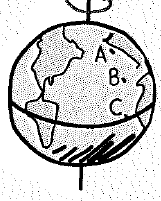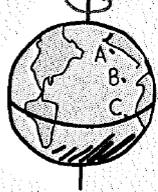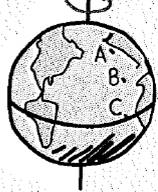
Concept explainers
Three locations on our rotating world are shown. Rank these locations from greatest to least for the following quantities.
a. rotational speed about Earth’s polar axis
b. tangential speed

(a)
To rank:The locations from greatest to least based on the given quantity.
Answer to Problem 15A
The rank of places based on the rotational speed about Earth’s polar axis from greatest to least is
Explanation of Solution
Given:
The three locations are shown below.

Formula used:
The rotational speed is the number of rotations per unit of time. It is expressed as revolutions per minute (RPM).
The expression for rotational speed is
Here,
Calculation:
The rotational speed of the Earth about its polar axis is same for all the locations.
All the three locations A, B, and C rotate about Earth’s polar axis in the same amount of time.
So the three locations A, B, and C have the same number of rotations.
Conclusion:
Thus, the rank of locations on the basis of rotational speed about Earth’s polar axis from greatest to least is
(b)
To rank:The locations from greatest to least based on the given quantity.
Answer to Problem 15A
The rank of the tangential speed from greatest to least is
Explanation of Solution
Given:
The three locations are shown below.

Formula used:
The speed of an object moving along a circular path is known as tangential speed. The direction of motion for the tangential speed is always tangent to the circle.
The expression for tangential speed is,
Here,
Calculation:
The rotational speed of the three locations A, B, and C have the same number of rotations.
Hence, the tangential speed is varies in direct proportion to the radial distance of the location from the rotational axis.
The radial distance of location A is nearer to the rotational axis when compared to the locations B and C.
The radial distance of location C is farther away from the rotational axis when compared to the locations A and C.
Hence, the rank of the tangential speed from greatest to least is
Conclusion:
Thus, the rank of the tangential speed from greatest to least is
Chapter 10 Solutions
CONCEPTUAL PHYSICS-W/PRACTICING PHYSICS
Additional Science Textbook Solutions
Human Anatomy & Physiology (2nd Edition)
Chemistry: Structure and Properties (2nd Edition)
Introductory Chemistry (6th Edition)
Campbell Biology (11th Edition)
Microbiology: An Introduction
Campbell Biology in Focus (2nd Edition)
- 1. An ideal gas is taken through a four process cycle abcda. State a has a pressure of 498,840 Pa. Complete the tables and plot/label all states and processes on the PV graph. Complete the states and process diagrams on the last page. Also, provide proper units for each column/row heading in the tables. Pressure (Pa) 500,000 450,000 400,000 350,000 300,000 250,000 200,000 150,000 100,000 Process ab bc cd da States P( ) V( ) 50,000 0 0.000 T = 500 K T= 200 K 0.001 0.002 0.003 0.004 0.005 Volume (m^3) Nature of Process isothermal expansion to Vb = 0.005 m³ (T = 500 K) isometric isothermal compression to V₁ = 0.003 m³ (T = 200 K) adiabatic compression to VA = 0.001 m³ b C a T() U ( ) Processes a-b Q( ) +802.852 W() AU ( ) b-c c→d +101.928 da Cyclearrow_forwardPlz no chatgpt Iarrow_forwardA = 45 kN a = 60° B = 20 kN ẞ = 30° Problem:M1.1 You and your friends are on an archaeological adventure and are trying to disarm an ancient trap to do so you need to pull a log straight out of a hole in a wall. You have 1 rope that you can attach to the log and there are currently 2 other ropes and weights attached to the end of the log. You know the force and direction of the ropes currently attached are arranged as shown below what is the magnitude and direction 'e' of the minimum force you need to apply to the third rope for the force on the log to be in direction of line 'a'? What is the resultant force in direction 'a'? a ////// //////arrow_forward
- answer both questionsarrow_forward- 13- 3. Shastri recalled reading that for an ideal transformer, "the ratio of the primary voltage to the secondary voltage is equal to the ratio of the secondary current to the primary current." Plan and design an experiment to investigate whether the statement above is true. (8) • With the aid of a fully labelled circuit diagram, describe a procedure which can be used to investigate whether the statement is true. The circuit diagram must include the following components: A variable AC voltage supply • AC voltmeters • AC ammeters A transformer with adjustable turns ratio Connecting wires • ° A load resistorarrow_forwardanswer question 1-6arrow_forward
- Fractions 1. Covert 5/7 to a decimal 2. 5/7 x 3/8 3. 2/5 divided 4/9 4. covert 37/ 19 to a decimalarrow_forwardthis is an exam past paper question that i need help with becuase i am reviewing not a graded assignmentarrow_forwardsunny (1) -13- end. One box contains nothing inside; one has a piece of resistance wire between the terminals You are provided with three sealed identical matchboxes labelled A, B and C, with terminals at each and the other, a semi-conductor diode. Plan and design an experiment to identify the contents of each box. You are provided with the following elements for your apparatus: Ammeter Low voltage power supply Connecting wires Labelled circuit diagram Draw a well-labelled circuit diagram to show how you would connect the apparatus listed above to each matchbox. (3 maarrow_forward
- RAD127 Radiographic Equipment and Computers SI Units in Radiography Ch. 1 & 2 Instructions: Provide the units for each of the following in full and short forms 1. Mass - kg, 9 or (1b)) ・ 2. Energy, Work - W = FD,J 3. Air kerma -(Gya) 4. Absorbed Dose- 5. Effective Dose J/kg (94+) jlkg J/kg, Sv 6. Radioactivity - 5-1, Bq 7. Weight 8. Time 9. Force 10. Power B9 wt, wt-mg, N -(s) F= ma, N, OR 1b. (JIS), P= work It = Fdlt, Jarrow_forwardanswer 1-8arrow_forward1 . Solve the equation 2/7=y/3 for y. 2. Solve the equation x/9=2/6 for x. 3. Solve the equation z + 4 = 10 This is algebra and the equation is fraction.arrow_forward
 College PhysicsPhysicsISBN:9781305952300Author:Raymond A. Serway, Chris VuillePublisher:Cengage Learning
College PhysicsPhysicsISBN:9781305952300Author:Raymond A. Serway, Chris VuillePublisher:Cengage Learning University Physics (14th Edition)PhysicsISBN:9780133969290Author:Hugh D. Young, Roger A. FreedmanPublisher:PEARSON
University Physics (14th Edition)PhysicsISBN:9780133969290Author:Hugh D. Young, Roger A. FreedmanPublisher:PEARSON Introduction To Quantum MechanicsPhysicsISBN:9781107189638Author:Griffiths, David J., Schroeter, Darrell F.Publisher:Cambridge University Press
Introduction To Quantum MechanicsPhysicsISBN:9781107189638Author:Griffiths, David J., Schroeter, Darrell F.Publisher:Cambridge University Press Physics for Scientists and EngineersPhysicsISBN:9781337553278Author:Raymond A. Serway, John W. JewettPublisher:Cengage Learning
Physics for Scientists and EngineersPhysicsISBN:9781337553278Author:Raymond A. Serway, John W. JewettPublisher:Cengage Learning Lecture- Tutorials for Introductory AstronomyPhysicsISBN:9780321820464Author:Edward E. Prather, Tim P. Slater, Jeff P. Adams, Gina BrissendenPublisher:Addison-Wesley
Lecture- Tutorials for Introductory AstronomyPhysicsISBN:9780321820464Author:Edward E. Prather, Tim P. Slater, Jeff P. Adams, Gina BrissendenPublisher:Addison-Wesley College Physics: A Strategic Approach (4th Editio...PhysicsISBN:9780134609034Author:Randall D. Knight (Professor Emeritus), Brian Jones, Stuart FieldPublisher:PEARSON
College Physics: A Strategic Approach (4th Editio...PhysicsISBN:9780134609034Author:Randall D. Knight (Professor Emeritus), Brian Jones, Stuart FieldPublisher:PEARSON





